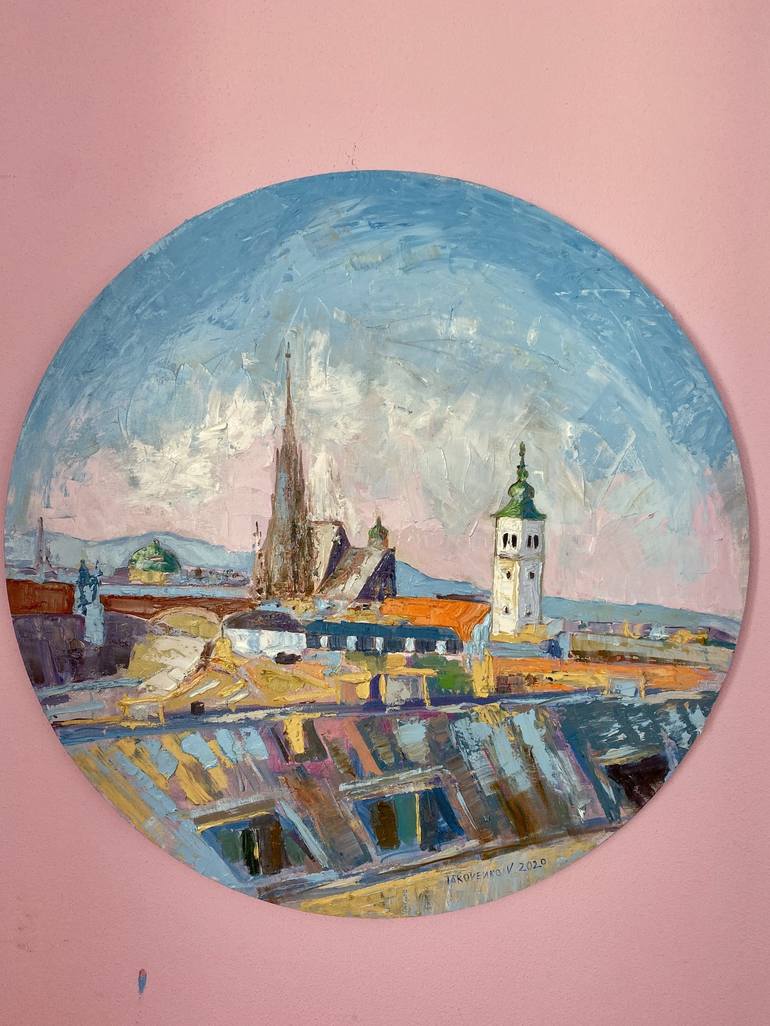





VIEW IN MY ROOM
Vienna Print
Slovakia
Select a Material
Fine Art Paper
Select a Size
9 x 12 in ($40)
Add a Frame
White ($80)
Artist Recognition

Artist featured in a collection
About The Artwork
Metamorphosen der Avantgarde: Vladislava Yakovenko Sehr oft bauen Lehrbücher für Kunstgeschichte ein ziemlich harmonisches Panorama der linearen Entwicklung diverser Kunststile und Kunstrichtungen vor uns auf. Darin versuchen sie, sie alle chronologisch darzustellen, eins nach dem anderen. Aber in dieses stark zusammengefasste Schema passen viele Nuancen in der Periodisierung der Kunstgeschichte nicht rein, solche wie z. B. die parallele Existenz der Gotik und der Entstehung der Renaissance, die gleichzeitige Herausbildung des Klassizismus und des Barocks, geschweige schon von der Verschmelzung verschiedener Strömen und Richtungen, die wir als „Avantgarde des 20. Jahrhunderts“ bezeichnen. Es existiert aber ein alternativer Blick, der den ganzen Kunstprozess wie Schwankungen eines Pendels zwischen Hauptpolen in der darstellenden Kunst darstellt. Eine dieser globalen Oppositionen ist die Linearität / das Malerische des Bildes. Zwei berühmte Kunstwissenschaftler der Moderne – Hubert Damisch und Rosalind Krauss – untersuchten die Wechselwirkung der Abbildung und der Leinwandoberfläche in den Arbeiten der Künstler verschiedener Epochen. Jeder von beiden Wissenschaftlern äußerte sein eigenes Verständnis für das Wesen der Kunst; die Vereinigung ihrer Ideen ergibt ein ganzheitliches Bild der Pendelbewegung zwischen zwei formbildenden Konzeptionen – /Wolken/ (Erschaffung der Illusion der Tiefe und des Raums) und Gitter (Akzente auf der Abbildungsfläche). Die junge ukrainische Malerin Vladislava Yakovenko strebt in ihrem Werk danach, eine Balance zwischen diesen zwei Methoden zu finden. Mimesis und Narrativik der akademischen Kunst sind für sie nicht zufriedenstellend. Und sie schlägt mit ihren Werken den gleichen Weg ein, den die Avantgardisten in den Jahren 1910-1920 durchgingen. Genau zu dieser Zeit versuchte die Malerei eine Antwort zu finden, was die Natur und die Einmaligkeit ihrer Sprache ausmacht. Dies führte zu einer radikalen Verschiebung der Akzente vom Motiv auf die visuelle Qualität des Gemäldes – die Künstler waren fasziniert von der absoluten Selbstgenügsamkeit des Aufbaus, der Oberflächenbeschaffenheit, der Farbe und verzichteten sich auf die Versuche, eine objektive Realität darzustellen, indem sie die Wichtigkeit eines eigenen Weltbildes verstanden. Vladislava selbst weist auf den Zusammenhang zwischen ihren Werken und dem Suprematismus, obwohl sie eher der Ästhetik des Orphismus näher sind, das sich in der französischen Kunst 1910 entwickelte. Trotzdem die Prinzipen aus der Geometrisierung der Form und der betonten Ebenheit der Abbildung entlehnt sind, die für Malevich und seine Anhänger charakteristisch waren, schenkt die Malerin ihre allererste Aufmerksamkeit der Poetik der Farbe. Wie die Orphisten formt sie den Raum und variiert seine Tiefe und Dichte durch die Farbe, ihren Sättigungsgrad, ihre Kombination mit den anderen Kontrastfarben. „Der simultane Kontrast ist eine sichtbare Tiefe der Realität, der Form, der Konstruktion, des Bildes. Die Tiefe ist eine Inspiration der neuen Epoche“, schrieb Gründer des Orphismus Robert Delaunay in seinen Notizen.
Details & Dimensions
Print:Giclee on Fine Art Paper
Size:9 W x 12 H x 0.1 D in
Size with Frame:14.25 W x 17.25 H x 1.2 D in
Frame:White
Ready to Hang:Yes
Packaging:Ships in a Box
Shipping & Returns
Delivery Time:Typically 5-7 business days for domestic shipments, 10-14 business days for international shipments.
Handling:Ships in a box. Art prints are packaged and shipped by our printing partner.
Ships From:Printing facility in California.
Have additional questions?
Please visit our help section or contact us.
Slovakia
METHAMORPHOSES OF AVANT-GARDE: VLADISLAVA IAKOVENKO In her works, young Ukrainian artist Vladislava Iakovenko aims to find balance between these two methods. Being unsatisfied with mimetic and narrative character of Academic art, she follows the pass of avant-gardists of 1910s – 1920s. It was exactly the time when painting looked for the answer concerning the essence and uniqueness of its own language. This led to the radical shift from the plot to the visual qualities of a canvas: masters were enchanted with the absolute self-sufficiency of compositions, texture, and colour. They rejected the attempts of objective depiction of the reality after realizing the value of their own worldview. Vladislava herself points out the connection of her pieces with Suprematism, though they are closer to the aesthetics of Orphism, which had originated in French art in 1910s. Despite inheriting the principles of geometrization of forms and exaggerated flatness of image, typical for the oeuvre of Malevich and his followers, the artist pays main attention to the poetics of colour. As well as the orphists, she ‘sculpts’ space and varies its depth and density through hues, its intensity and combinations. “Simultaneous contrast is the most up-to-date honey of this technique in this field. Simultaneous contrast is visible depth – Reality, Form, construction, representation. Depth is the new inspiration,” as Robert Delaunay wrote in his notes, the founder of Orphism. Vladislava applies the mentioned methods of Abstract painting working on figurative compositions. She ‘grows’ a sort of painting crystal, mosaic of pure forms and lines that blends into familiar images – landscape, portrait, nude. Complicated structural and colouristic scheme adds the artist’s pieces certain dynamism, typical for our days; at the same time, they seem to remain in timelessness. Yet, in some of the paintings, the traces of reality become rather tangible. The events of recent years on the Motherland that has affected Vladislava’s life, prompted her to create several collage works dedicated to the Revolution of Dignity and war on the East of Ukraine. Painting was combined with photography and newspaper clippings that allow depicting tension, deep dramatism of the situation and personal experience of the author. Doubtlessly, Vladislava Iakovenko is still searching for her creative identity, however she has already made herself known.
Artist Recognition

Artist featured by Saatchi Art in a collection
Thousands Of Five-Star Reviews
We deliver world-class customer service to all of our art buyers.
Global Selection
Explore an unparalleled artwork selection by artists from around the world.
Satisfaction Guaranteed
Our 14-day satisfaction guarantee allows you to buy with confidence.
Support An Artist With Every Purchase
We pay our artists more on every sale than other galleries.
Need More Help?